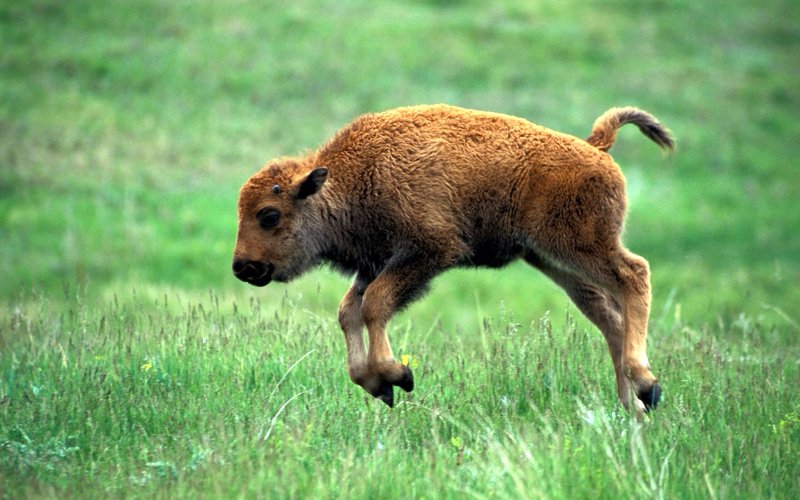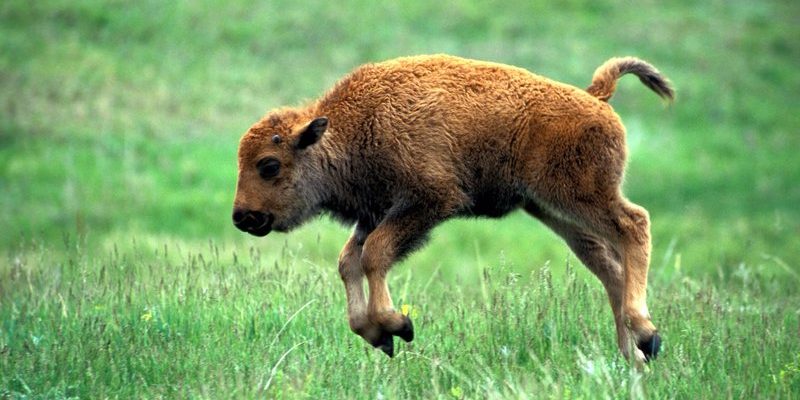
Imagine this: a mother bison and her newborn calf, standing together on the vast prairie. The mother’s deep bond with her calf is essential for survival. This connection isn’t just about feeding; it’s about teaching, protecting, and guiding the young bison as it learns to navigate its world. Just like a parent protecting a child, the mother bison uses her instincts and knowledge to keep her little one safe from predators while teaching it where to find food and water. Let’s dive deeper into the remarkable ways bison raise their young.
The Birth of a Calf
The bison’s reproductive cycle is fascinating, starting with a gestation period of about nine months. That’s almost like a human pregnancy! When the time is right, usually in spring, a mother bison finds a quiet, safe spot to give birth. She often isolates herself from the herd to ensure privacy and reduce stress.
Once the calf is born, it’s usually on its feet within just a few hours. This quick mobility is essential for survival, as it needs to keep up with the herd to avoid predators like wolves or mountain lions. The mother uses her body to shield the calf and keep it close. You might imagine that while the calf is learning to walk, it’s also learning to follow its mother’s lead, a crucial lesson in their wild world.
Maternal Care and Milk Feeding
After birth, feeding is the first priority. A mother bison produces a nutrient-rich milk that helps her calf grow rapidly. This milk is high in fat and protein, perfect for a growing baby. For the first few months, the calf relies entirely on this milk for food.
Here’s the thing: while the calf is drinking, the mother remains alert. She stays watchful for any potential threats. You might picture her as a protective guardian, always aware of her surroundings. This vigilance creates a safe environment for the calf to thrive. As time passes, the calf will start to nibble on grass, but the bond between mother and calf remains strong, with milk being an essential part of its diet for quite a while.
Teaching Essential Survival Skills
As the bison calf grows, the mother begins to teach it essential survival skills. These lessons are crucial for its future in the wild. For example, the mother leads her calf to water sources, teaches it how to graze on grass, and helps it recognize signs of danger.
You might wonder how a mother communicates these lessons. Bison use a combination of body language and vocalizations, including low grunts and bellows. Through these sounds, the calf learns what to pay attention to and what behaviors are safe or dangerous. Over time, the calf becomes more independent, but it still depends on its mother for guidance in those early formative days.
Protective Behavior of the Herd
Bison don’t just rely on individual mother-calf relationships; they also have a strong social structure within the herd. This community aspect offers additional protection. When a predator approaches, the entire herd often comes together to defend their young.
Imagine a group of bison forming a protective circle around the calves, heads lowered, ready to charge at any threat. This behavior not only safeguards the young but also reinforces social bonds among the adults. It’s a team effort! By working together, the herd increases the chances of survival for all its members, especially the vulnerable calves.
The Role of the Seasons in Raising Calves
The changing seasons play a significant role in how bison raise their young. Spring and summer are busy times for calf-rearing. With plenty of grass and water available, the mothers can find the resources they need to nourish their young effectively.
As winter approaches, the challenges become greater. The mother must teach her calf how to find food in harsher conditions. Bison are known to dig through the snow to reach grass underneath, and this is a crucial skill the calf must learn before its first winter. The bond between mother and calf becomes even more critical as they face the elements together, navigating through snow and seeking shelter from the cold.
Independence and Leaving the Nest
Around six months old, bison calves start to wean off their mother’s milk. This transition signals the beginning of their journey towards independence. During this time, the mother has to balance between nurturing her calf and allowing it to explore on its own.
Here’s where it gets interesting. The calf will begin to spend short periods away from its mother, practicing its grazing skills and interacting with other young bison. This socialization is essential as it prepares the calf for life in the herd. It’s like how kids might play in a park, learning social skills while their parents keep an eye on them from a distance.
The Long-Term Bond
Even as the calf matures and becomes more independent, the bond between a mother bison and her offspring remains significant. This long-term relationship isn’t just about physical survival; it’s also about emotional support within the herd.
Adult bison often stay close to their mothers for several years, and they may even return to the family unit when facing challenges. The lessons learned during their early days help guide their behavior as adults, influencing their participation in the herd’s social dynamics. This ongoing support exemplifies the depth of maternal care in the wild.
Bison are remarkable creatures with a unique approach to raising their young. From birth to independence, mothers play a crucial role in teaching their calves how to survive in the wild. Through a blend of maternal care, community protection, and lessons learned through seasons, these animals embody the balance of nurturing and self-sufficiency.
As you reflect on the lives of bison, think about the resilience and strength they demonstrate. Their stories remind us of the importance of family, community support, and the bonds that form in nature. Watching bison raise their young is not just about survival; it’s a beautiful testament to life itself.

